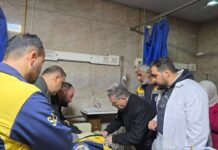
Yesterday, a new initiative was announced by several military revolutionary factions in northern Aleppo. In a significant development, these major factions have decided to cooperate in the establishment of a military and security coordination body known as the Unified Force (UF). This alliance aims to enhance military and security efforts, foster cooperation among member factions, and maintain stability in the liberated areas. The formation of the Unified Force marks a significant step in the ongoing efforts to secure and stabilize Northern Aleppo.
L24 spoke with Sirajuddin Omar, Director of the Media Office for Jabha Shamiya (JS), to gain insights into the objectives, structure, and implications of this new alliance. Omar told L24 the groups had three main goals for the body, improved military coordination across all fronts, enhanced security coordination and creation of an area control, and the prevention of internal conflicts.
Chief among the objectives is enhancing military coordination on the various battlefronts in northern Aleppo. By pooling their resources and expertise, the participating factions, including Jabha Shamiya (JS), Mutasim, and Tajamu Al-Shuhaba (TAS), can mount a more effective response to threats and establish a stronger collective defense against outside forces. This increased coordination will likely lead to improved operational efficiency and a higher likelihood of success in military operations.
According to Omar, security within the liberated areas is a top priority for the Unified Force. The council aims to establish control over these regions, ensuring the safety and protection of residents and resources. Via unified efforts, the participating factions can effectively coordinate security measures, share intelligence, and implement joint patrols within the region. Such an approach will help create a more secure environment while reducing the risk of infiltration by hostile elements and providing a sense of stability for the local population.
Another key objective, stressed Omar, is to prevent internal conflicts within the area. By fostering cooperation and coordination among different factions, the council seeks to minimize disputes and maintain overall stability. This initiative encourages dialogue and consensus-building among the participating factions, reducing the likelihood of infighting and promoting a united front against common threats. Through establishing de-escalation and conflict resolution mechanisms UF can focus its efforts on external challenges, further strengthening its position.
It is important to note that UF is not a merger of the participating factions but rather a coalition to facilitate inter-faction coordination. Each faction retains its independence, allowing them to preserve their distinct identities and maintain existing structures. The strength of this initiative lies in the collaboration and connections forged within the framework of these factions. This approach enables groups to pool their resources and expertise while respecting individual autonomy.
The Unified Force is not limited to these initial three factions, rather there is also potential for additional groups from the Syrian National Army (SNA) to join in the coming days. While some groups within the SNA may choose not to participate, the diversity within the army allows for flexibility in decision-making. The inclusion of more factions under the UF umbrella would further enhance its capabilities and broaden its reach. The future will reveal the impact and success of this coordination effort, but the UF holds the potential to create a more secure and stable environment for the people of northern Aleppo.








